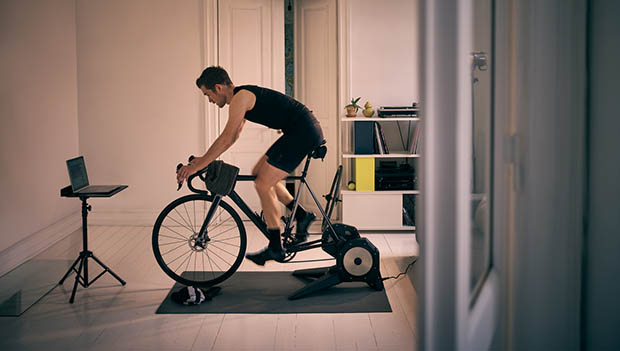
Riding inside doesn't only have to be about staying warm during the cold winter months. It can also be a great way to have effective workouts free from motor vehicles, traffic lights and other distractions and obstacles. Distractions are at a minimum, and you can get high-quality, repeatable data from uninterrupted sessions.
The Right Gear
The best environment for inside cycling is one that is well-ventilated. You'll want a fan to move air and too help keep your core temperature down. A smart trainer, like a Wahoo Kickr, is a worthwhile investment; buying any indoor trainer onto which you can mount your bike will do. If you have a power meter and a heart rate monitor, you'll have all the data you need to measure and improve your fitness.
Fitness Assessment
Test yourself. A 20-minute, all-out FTP Test is a good benchmark. Use the results to set workouts and measure improvements. Retest every 4 to 6 weeks, replicating the same conditions and protocols. When retesting, compare your power outputs with your heart rates over multiple training periods. Ideally, you want to generate more power with the same or lower heart rate over the same duration for each time you retest. It's OK if improvements are small.
Virtual Cycling
If you're a TrainerRoad or Zwift user, the included training plans can make improving your fitness simple. And they are a great distraction from staring at a wall while allowing more focus than watching TV as a distraction.
Your Training Calendar and Periodicity
If you're self-coaching or following an online training plan, you should still base your training on a 3- or 4-week period with the week following as a rest and test week.
Vary Sessions
Don't do the same workout day after day or even on successive weeks. Vary your workouts by power, cadence, duration and recovery for variety and physiological benefit. If you want to do a 3-week build and then repeat a series of workouts in successive builds, you'll be able to compare workout results. Beware of monotony and getting locked into a repetitive rut and you won't burn out.
Don't Always Go Hard
This bears repeating: Rest and recovery are very important components of successful training. Going easy—Zone 1 or Zone 2—allows for adaptation without further taxing your system for successive training sessions. It's OK to go 48 hours between hard sessions to achieve full recovery.
Build Base
This is where you lay the foundation for tearing up the miles outside. Rides of 90 to 120 minutes at a low to moderate effort but above recovery pace develop your capacity to do the hard work. Without a base, you won't be able to go hard for very long.
Steady State for the Win
Sweet-spot training has so many positive benefits for a relatively short amount of time. You'll want to do this kind of work at least once per week. Warm up for 10 to 12 minutes before and cool down for at least 10 minutes following each session.
- 2 x 20 minutes at FTP or LTHR, with 8 to 10 minutes recovery
- 3 x 15 minutes at FTP or LTHR, with 5 minutes of recovery
- 4 x 3 minutes at 105% FTP, 2 minutes at 85% FTP with 5 minutes easy between sets
Power Over Punchy Climbs
If there's a climb you want to conquer that's 5 minutes or less, train for it by doing shorter intervals. This kind of training is an ideal way to improve on climbs that could last between 2 minutes and 10 minutes.
- 5 x 5 minute repeats at 120% FTP, with 5 minutes of recovery; use a cadence that’s 10 rpms lower than your norm
- 10 x 4 minutes at 110% FTP and 2 minutes at 70rpms, then 2 minutes at 90 rpms before recovering for 2 minutes
Sprint for the Win
Improving your sprint or climbs that take less than two minutes is not easy, but it's so satisfying and an efficient workout. For high-intensity sessions you'll want to warmup and cool down for about 20 minutes. Alternate these or similar workouts every other week.
- 2 sets of 5 x 1 minute all-out efforts, spin for 5 minutes at a very easy pace between efforts
- 2 sets of 10 x 20 seconds on 40 seconds off. The 20-second intervals are all-out, as hard as you can go, using as high a cadence as you can spin
Practice Nutrition and Hydration Strategies
Riding inside where it's likely to be warm and dry is a great opportunity to experiment with and dial in your on-the-bike nutrition and hydration game. This becomes especially important for any duration greater than an hour. If you're going to be riding for more than 90 minutes, consider taking a gel every 45 minutes or so and taking in electrolyte and/or carb replenishment liquid.
Bring It All Outside
Be patient. Improving fitness takes time, and the journey is worth it. Approach climbing on the bike by pacing yourself tactically with your newfound fitness so you can keep accelerating, not doing a fly-and-die. When you're sprinting—for a town line or a road race win—also be patient: Let someone else do the lead-out and then apply that sprint you've been working on in your pain cave, and come around them, leaving them with no distance to come back around you.
READ THIS NEXT: The Best Gear for Indoor Training


